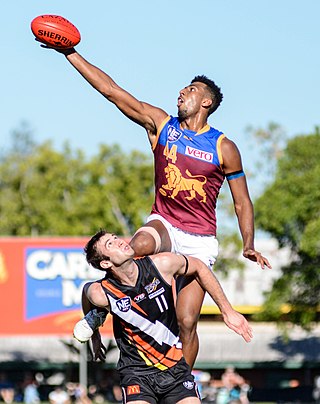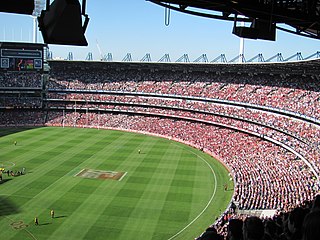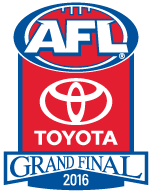Related Research Articles

Australian rules football, also called Australian football or Aussie rules, or more simply football or footy, is a contact sport played between two teams of 18 players on an oval field, often a modified cricket ground. Points are scored by kicking the oval ball between the central goal posts, or between a central and outer post.

A mark in Australian rules football is the catch of a kicked ball which earns the catching player a free kick. The catch must be cleanly taken, or deemed by the umpire to have involved control of the ball for sufficient time. A tipped ball, or one that has touched the ground cannot be marked. Since 2002, in most Australian competitions, the minimum distance for a mark is 15 metres.

Recreational Football was a non-contact version of the Australian rules football game first played in 2003 and later sanctioned by the Australian Football League's game development arm, it was inspired heavily by the growing popularity of tag rugby. It was a more accessible version of Australian rules football that people could pick up and play. It was a mixed competition, with eight players on each team, accessible to players of both sexes, all shapes and sizes and requires minimal equipment to play. Rec Footy was criticised mainly by Australian rules players for appearing similar to netball and being too restrictive, lacking of ability for skilled footballers to run kick and play naturally whilst also penalising newer unskilled players with frequent turnovers.

The laws of Australian rules football were first defined by the Melbourne Football Club in 1859 and have been amended over the years as Australian rules football evolved into its modern form. The Australian Football Council (AFC), was formed in 1905 and became responsible for the laws, although individual leagues retained a wide discretion to vary them. Following the restructure of the Victorian Football League's competition as a national competition and the League's renaming to be the Australian Football League (AFL), since 1994, the rules for the game have been maintained by the AFL through its Commission and its Competition Committee.
In the Australian Football League (AFL), previously the Victorian Football League (VFL), the pre-season competition, known during its history by a variety of sponsored names and most recently as the NAB Cup, was an annual Australian rules football tournament held amongst clubs prior to the premiership season between 1988 and 2013. The pre-season competition culminated annually in a grand final and pre-season premier.

Brent Guerra is a former Australian rules football player who played with the Port Adelaide Football Club, St Kilda Football Club, and Hawthorn Football Club in the Australian Football League.
In the sport of Australian rules football, the 50-metre penalty is an additional penalty applied by umpires for an infractions after a free kick or mark has already been paid.
A super goal was a method of scoring used in the Australian Football League's pre-season competition in the sport of Australian rules football, from 2003 to 2017. Under the rule, a goal scored from a distance greater than fifty metres is awarded nine points, instead of the regulation six points. The innovation is not used during the premiership season.

Stephen Milne is a former professional Australian rules footballer who played for the St Kilda Football Club in the Australian Football League (AFL). A small forward, he held the record for the most games played by a player originally drafted via the Rookie Draft, however this was surpassed by the West Coast Eagles' Dean Cox in early 2014.

In the sport of Australian rules football, a kick-in is the common name for the procedure to restart the game after a behind. It involves a defender from the team who did not score kicking the ball back into play from the defensive goal square.

A ball-up in Australian rules football is the method by which the field umpire restarts play at a neutral contest after a stoppage within the field of play. It involves the throwing or bouncing of the ball up between two players, known as rucks, who then attempt to win possession for their teams.
The 1964 VFL Grand Final was an Australian rules football game contested between the Collingwood Football Club and Melbourne Football Club, held at the Melbourne Cricket Ground in Melbourne on 19 September 1964. It was the 67th annual Grand Final of the Victorian Football League, staged to determine the premiers for the 1964 VFL season. The match, attended by 102,471 spectators, was won by Melbourne by a margin of 4 points, marking the club's 12th premiership victory.
Variations of Australian rules football are games or activities based on or similar to the game of Australian rules football, in which the player uses common Australian rules football skills. They range in player numbers from 2 up to the minimum 38 required for a full Australian rules football.

This list is an alphabetical glossary of Australian rules football terms, jargon and slang. While some of these entries are shared with other sports, Australian rules football has developed a unique and rich terminology.
In Australian rules football, a rushed behind occurs when the ball passes through the goalposts and was last touched by a defending player. A rushed behind scores one point for the attacking team, but it also prevents the attacking team from scoring a goal, worth six points.
The 1996 AFL Lightning Premiership was an Australian rules football knock-out competition, played in its entirety before the Australian Football League's main pre-season competition began. The Lightning Premiership was held for the only time in the modern era in 1996 - the Centenary Season of the AFL. It was a knock-out competition played from Friday, 9 February until Sunday, 11 February, with four games each evening at Waverley Park, each consisting of two 17.5-minute halves. The game trialled a number of highly experimental rules, including three points awarded both for deliberate rushed behinds and balls which hit the goalposts, and timekeepers not blowing the siren if scores were tied. However, the rule which altered play most significantly was the ball not being thrown in from the boundary line after travelling out of bounds, a free kick being awarded instead against the last team to touch the ball. Essendon won the title defeating Brisbane by 17 points in the Grand Final.

The 2011 AFL Grand Final was an Australian rules football game contested between the Collingwood Football Club and the Geelong Football Club, held at the Melbourne Cricket Ground on 1 October 2011. It was the 116th annual grand final of the Australian Football League, staged to determine the premiers for the 2011 AFL season. The match, attended by 99,537 spectators, was won by Geelong by a margin of 38 points, marking the club's ninth VFL/AFL premiership victory. Geelong's Jimmy Bartel was awarded the Norm Smith Medal as the best player on the ground.

The 2016 AFL Grand Final was an Australian rules football game contested between Sydney and the Western Bulldogs at the Melbourne Cricket Ground on 1 October 2016. It was the 121st annual Grand Final of the Australian Football League, staged to determine the premiers of the 2016 AFL season. The match, attended by 99,981 spectators, was won by the Bulldogs by a margin of 22 points, marking the club's second VFL/AFL premiership victory and first since 1954. It was the first time in VFL/AFL history that a team won the premiership from seventh place on the ladder. Jason Johannisen of the Bulldogs was awarded the Norm Smith Medal as the best player on the ground.

The 2017 AFL Grand Final was an Australian rules football game contested between the Adelaide Football Club and the Richmond Football Club at the Melbourne Cricket Ground on 30 September 2017. It was the 122nd annual grand final of the Australian Football League staged to determine the premiers for the 2017 AFL season. The match, attended by 100,021 spectators, was won by Richmond by a margin of 48 points, marking the club's eleventh VFL/AFL premiership and first since 1980. Richmond's Dustin Martin was awarded the Norm Smith Medal as the best player on the ground.
AFLX is a variation of Australian rules football designed in 2017 to be played on a soccer field. Unlike the full 18-a-side game, AFLX required fewer players with some modified rules aimed at generating higher scores, including increased scoring points. It was founded in an attempt to appeal to a wider audience outside of its origin country of Australia. The AFL billed AFLX as its answer to Twenty20 or Rugby Sevens.